 W
WCoal mining is the process of extracting coal from the ground. Coal is valued for its energy content and since the 1880s, has been widely used to generate electricity. Steel and cement industries use coal as a fuel for extraction of iron from iron ore and for cement production. In the United Kingdom and South Africa, a coal mine and its structures are a colliery, a coal mine is a 'pit', and the above-ground structures are a 'pit head'. In Australia, "colliery" generally refers to an underground coal mine. In the United States, "colliery" has been used to describe a coal mine operation, but this usage is less common.
 W
WAnthracite, also known as hard coal, is a hard, compact variety of coal that has a submetallic luster. It has the highest carbon content, the fewest impurities, and the highest energy density of all types of coal and is the highest ranking of coals.
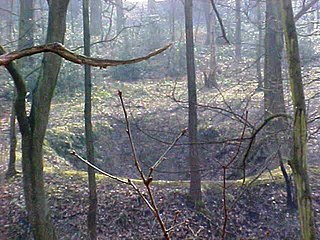 W
WA bell pit is a primitive method of mining coal, iron ore or other minerals where the coal or ore lies near the surface.
 W
WBirkner is a populated area in St. Clair County, Illinois. It is located at 38.562°N 90.029°W. A mine of the same name operated from prior to 1882 to 1889. During that time, the mine was operated by Edward Avery & Company, Dutch Hollow Coal Company, and the Consolidated Coal Company of St. Louis.
 W
WBootleg mining or shoemaker mining is a form of illegal coal mining.
 W
WA breaker boy was a coal-mining worker in the United States and United Kingdom whose job was to separate impurities from coal by hand in a coal breaker. Although breaker boys were primarily children, elderly coal miners who could no longer work in the mines because of age, disease, or accident were also sometimes employed as breaker boys. The use of breaker boys began in the mid-1860s. Although public disapproval of the employment of children as breaker boys existed by the mid-1880s, the practice did not end until the 1920s.
 W
WA checkweighman is a person who is responsible for weighing coal or another mined substance, and thereby determining the payment due to each worker.
 W
WCoal is a combustible black or brownish-black sedimentary rock, formed as rock strata called coal seams. Coal is mostly carbon with variable amounts of other elements; chiefly hydrogen, sulfur, oxygen, and nitrogen. Coal is formed when dead plant matter decays into peat and is converted into coal by the heat and pressure of deep burial over millions of years. Vast deposits of coal originate in former wetlands—called coal forests—that covered much of the Earth's tropical land areas during the late Carboniferous (Pennsylvanian) and Permian times.
 W
WA coal preparation plant is a facility that washes coal of soil and rock, crushes it into graded sized chunks (sorting), stockpiles grades preparing it for transport to market, and more often than not, also loads coal into rail cars, barges, or ships.
 W
WA coal preparation plant is a facility that washes coal of soil and rock, crushes it into graded sized chunks (sorting), stockpiles grades preparing it for transport to market, and more often than not, also loads coal into rail cars, barges, or ships.
 W
WCoal is a combustible black or brownish-black sedimentary rock, formed as rock strata called coal seams. Coal is mostly carbon with variable amounts of other elements; chiefly hydrogen, sulfur, oxygen, and nitrogen. Coal is formed when dead plant matter decays into peat and is converted into coal by the heat and pressure of deep burial over millions of years. Vast deposits of coal originate in former wetlands—called coal forests—that covered much of the Earth's tropical land areas during the late Carboniferous (Pennsylvanian) and Permian times.
 W
WA coal-seam fire is a burning of an outcrop or underground coal seam. Most coal-seam fires exhibit smoldering combustion, particularly underground coal-seam fires, because of limited atmospheric oxygen availability. Coal-seam fire instances on Earth date back several million years. Due to thermal insulation and the avoidance of rain/snow extinguishment by the crust, underground coal-seam fires are the most persistent fires on Earth and can burn for thousands of years, like Burning Mountain in Australia. Coal-seam fires can be ignited by self-heating of low-temperature oxidation, lightning, wildfires and even arson. Coal-seam fires have been slowly shaping the lithosphere and changing atmosphere, but this pace has become fast and extensive at modern times, triggered by enormous mining activities.
 W
WA tipple is a structure used at a mine to load the extracted product for transport, typically into railroad hopper cars. In the United States, tipples have been frequently associated with coal mines, but they have also been used for hard rock mining.
 W
WCOALSCAN is a brand of an online coal measurement systems developed by Scantech Limited . COALSCAN analysis is a system for the on-line measurement of the mineral, moisture and ash content of coal and coal products. COALSCANs provide real time information for the quality and specification control of coal. The instruments are made in Adelaide and sold to companies worldwide.
 W
WEnde Gelände is a civil disobedience movement occupying coal mines in Germany to raise awareness for climate justice. Ende Gelände has been organizing mass civil disobedience actions against coal mines in Rhineland, Lusatia and Leipzig since 2015. Since 2017 it has participated in civil disobedience protests against coal mining and fracking in Poland, the Netherlands and the Czech Republic. It supports Venice´s movement against big cruising ships. Annual protests in Germany have had from 3000 up to 7000 participants. It regularly supports anti-racist rallies in Germany and has hosted a range of smaller local protests since 2018.
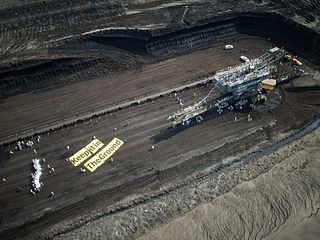 W
WEnde Gelände 2016 was a large civil disobedience protest movement in Germany to limit global warming through fossil fuel phase-out.
 W
WEnde Gelände 2017 was a large civil disobedience protest movement in Germany to limit global warming through fossil fuel phase-out.
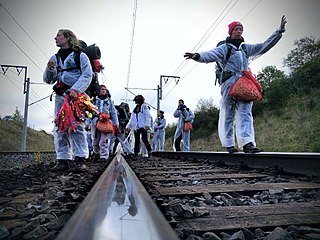 W
WEnde Gelände 2018 were a series of events of a mass movement for climate justice in the Rhenish lignite mining area in Germany. The non-violent direct action civil disobedience events were targeted against coal-based power generation through RWE Power AG and demanded the "immediate fossil fuel phase-out" based on climate justice and climate change mitigation.
 W
WEnde Gelände 2019 was a series of large-scale events of a movement for climate justice in Germany.
 W
WFunginite is a maceral, a component, organic in origin, of coal or oil shale, that exhibits several different physical properties and characteristics under particular conditions, and its dimensions are based upon its source and place of discovery. Furthermore, it is primarily part of a group of macerals that naturally occur in rocks containing mostly carbon constituents, specifically coal. Due to its nature, research into the chemical structure and formula of funginite is considered limited and lacking. According to Chen et al. referencing ICCP, 2001, alongside the maceral secretinite, they "are both macerals of the inertinite group, which is more commonly known as fossilized charcoal, and were previously jointly classified as the maceral sclerotinite". In the scientific community, the discernment between the two does not remain entirely clear, but there are slight particular and specific differences in regards to the composition between both. It is also the product of fungal development on these carbon rich sedimentary rocks.
 W
WHibernia 41-E and 42-E were steam locomotives of Hibernia AG. Locomotive No 42-E was scrapped, but No 41-E does still exist and was temporarily displayed in front of the Starlight Express Theater in Bochum.
 W
WA hurrier, also sometimes called a coal drawer or coal thruster, was a child or woman employed by a collier to transport the coal that they had mined. Women would normally get the children to help them because of the difficulty of carrying the coal. Common particularly in the early 19th century, the hurrier pulled a corf full of coal along roadways as small as 0.4 metres (16 in) in height. They would often work 12-hour shifts, making several runs down to the coal face and back to the surface again.
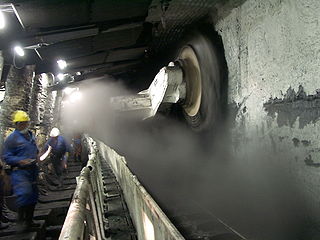 W
WLongwall mining is a form of underground coal mining where a long wall of coal is mined in a single slice. The longwall panel is typically 3–4 km (1.9–2.5 mi) long and 250–400 m (820–1,310 ft) wide.
 W
WA mining lamp is a lamp, developed for the rigid necessities of underground mining operations. Most often it is worn on a special safety helmet.
 W
WMountaintop removal mining (MTR), also known as mountaintop mining (MTM), is a form of surface mining at the summit or summit ridge of a mountain. Coal seams are extracted from a mountain by removing the land, or overburden, above the seams. This method of coal mining is conducted in the Appalachian Mountains in the eastern United States. Explosives are used to remove up to 400 vertical feet of mountain to expose underlying coal seams. Excess rock and soil is dumped into nearby valleys, in what are called "holler fills" or "valley fills". Less expensive to execute and requiring fewer employees, mountaintop removal mining began in Appalachia in the 1970s as an extension of conventional strip mining techniques. It is primarily occurring in Kentucky, West Virginia, Virginia, and Tennessee.
 W
WMusic of Coal: Mining Songs from the Appalachian Coalfields is a 70-page book and two CD compilation of old and new music from southern Appalachian coalfields. The project was produced by Jack Wright and is a benefit for the Lonesome Pine Office on Youth in Wise County, Virginia.
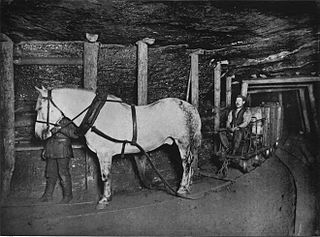 W
WA pit pony, otherwise known as a mining horse, was a horse, pony or mule commonly used underground in mines from the mid-18th until the mid-20th century. The term "pony" was sometimes broadly applied to any equine working underground.
 W
WThis is a list of countries by coal production, based mostly on the Statistical Review of World Energy ranking countries with coal production larger than 5 million tonnes.
 W
WThe Saar Polygon in Ensdorf, Saarland is a monument commemorating the coal mining industry in Saarland, which ended in June 2012.
 W
WThe Steamexfire is a high flow inert gas generator (IGG)
 W
WSunday stone is an artificial stone composed of porous barium sulfate that formed on the walls of drainage pipes of some coal mines. It is striped due to differing levels of coal dust produced during the day and night shifts. In some cases there is a broader stripe generated every seven days due to active mining not taking place on a Sunday. Broader stripes would also appear when work stopped for other reasons. In one case a broad stripe was found to coincide with workers being given the day off to view a cock fight. Breaks of more than a day would produce an even broader stripe such as when Christmas fell on a Monday.
 W
WA tipple is a structure used at a mine to load the extracted product for transport, typically into railroad hopper cars. In the United States, tipples have been frequently associated with coal mines, but they have also been used for hard rock mining.